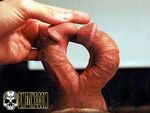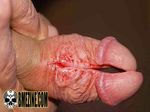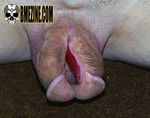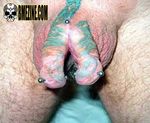Corset Piercings and Genital bisection: Difference between pages
(Page conversion via llm-mediawiki-rev -jwm) |
(Page conversion via llm-mediawiki-rev -jwm) |
||
| Line 1: | Line 1: | ||
{| | The process called '''genital bisection''' is the total splitting of genitals. It generally refers to doing this to the male genitals, specifically dividing the penis into usually symmetric halves. | ||
Partial splitting is either in length (ie. [[Head splitting]]) or in axis (the far more common [[Meatotomy]] and [[Subincision]] procedures where only the bottom of the shaft is split, or the very rare [[Superincision]] where only the top is split). Other variations include [[Inversion|inversion]] where the split leaves the glans intact, allowing the penis to be effectively ''"turned inside out."'' | |||
In most cases, the penis remains fully functional, although some rigidity loss is possible. The penis maintains its form by the two halves of the [[Corpus cavernosum]]. When they are no longer attached, the penis tends to curve in on itself (as seen in the first photo showing an erect full bisection), making insertion more difficult, but far from impossible. | |||
[[Nerve damage]] is a possibility in rare cases. | |||
{| class="wikitable" style="text-align:center" | |||
|- | |- | ||
| [[File: | | [[File:Genital_Bisection-1.jpg|150px|A bisected penis being held by a left hand, viewed from above]] | ||
| [[File: | | [[File:Genital_Bisection-2.jpg|150px|A bisected penis where the blood vessels are more easily visible because of pale skin, viewed from below, pelvis and navel visible]] | ||
| [[File:Genital_Bisection-3.jpg|150px|A bisected penis being held by a right hand, viewed from above, some scar tissue]] | |||
| [[File: | | [[File:Genital_Bisection-4.jpg|150px|A bisected penis viewed from above, pelvis and inner thighs visible]] | ||
| [[File: | | [[File:Genital_Bisection-5.jpg|150px|A bisected penis discolored green with a barbell piercing through the head]] | ||
|} | |} | ||
== Related articles == | |||
Risks: | |||
* [[Bleeding]] | |||
* [[Infection]] | |||
* [[Nerve damage]] | |||
Example: | |||
* [[ | * [[Carl Carrol]] | ||
See also: | |||
* [[ | * [[Bisection]] | ||
* [[Tongue splitting]] | |||
Latest revision as of 04:20, 17 September 2023
The process called genital bisection is the total splitting of genitals. It generally refers to doing this to the male genitals, specifically dividing the penis into usually symmetric halves.
Partial splitting is either in length (ie. Head splitting) or in axis (the far more common Meatotomy and Subincision procedures where only the bottom of the shaft is split, or the very rare Superincision where only the top is split). Other variations include inversion where the split leaves the glans intact, allowing the penis to be effectively "turned inside out."
In most cases, the penis remains fully functional, although some rigidity loss is possible. The penis maintains its form by the two halves of the Corpus cavernosum. When they are no longer attached, the penis tends to curve in on itself (as seen in the first photo showing an erect full bisection), making insertion more difficult, but far from impossible.
Nerve damage is a possibility in rare cases.

|

|

|

|

|
Related articles
Risks:
Example:
See also: